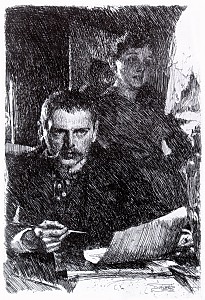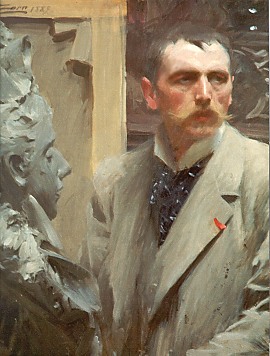
Anders
Zorn
1860-1920 |
The Self-Portraits of
Anders Zorn
The great Swedish master looks into the mirror.
 nders Zorn (1860-1920) occupies an enviable
place in art history. His name is invariably
included in an illustrious quartet of late nineteenth-century/early
twentieth century masters of the art of premier
coup (direct stroke) oil technique. The four
names which are customarily linked are: John
Singer Sargent (American), Joaquin Sorolla (Spanish),
Giovanni Boldini (Italian) and Zorn (Scandinavian).
Legion were (and are) the painters who have
attempted this very difficult and demanding
technique, but these four, working contemporaneously,
were the standard-bearers of the discipline
in their era.
nders Zorn (1860-1920) occupies an enviable
place in art history. His name is invariably
included in an illustrious quartet of late nineteenth-century/early
twentieth century masters of the art of premier
coup (direct stroke) oil technique. The four
names which are customarily linked are: John
Singer Sargent (American), Joaquin Sorolla (Spanish),
Giovanni Boldini (Italian) and Zorn (Scandinavian).
Legion were (and are) the painters who have
attempted this very difficult and demanding
technique, but these four, working contemporaneously,
were the standard-bearers of the discipline
in their era.
Zorn's work is always exciting. His draftsmanship
is superb. His brushwork is fresh, direct and
animated. His compositions are frequently unconventional.
For the working artist who needs inspiration
to free his hand from hesitation and restraint,
Zorn is the perfect artist to study. Here are
four examples of his brilliant work, all self-portraits:
 |
1. Self-Portrait With Sculpture
Painted
at 29, this portrait vividly exhibits
the Zorn trademark of extraordinarily
free brushwork, with a decided rhythm
of strokes blending from one form
into another, across the edges or
contours. The light here is falling
from a high source (possible a skylight).
This painting, like many Zorn works,
includes a strong story-telling
aspect—the young artist is
shown in his studio surrounded by
elements of his art: the back of
a large stretched canvas and a sculpture
work-in-progress.
The
working artist will note that the
very evident brushstrokes all move
in the direction of the form (i.e.,
down the lapels and the front of
the coat, across the forehead and
cheekbones.
Oil
on canvas, 29 x 25 inches
(74.5cm x 62.5cm)
Uffizzi, Florence
|
| page
1 2
3 4 |
|
The story of Anders
Zorn is one of a journey from poverty and
anonymity to wealth and international fame. He
was born February 18, 1860 in Mora, Sweden. Through
the generosity of friends, he was able to enter
the Royal Academy of Fine Arts in Stockholm, and
at the age of 18 he sold his first painting, Zorn
showed an early proficiency in portraiture.
By the age of 22,
Zorn had established himself as a professional
portraitist in London. In 1888, Zorn, by then
married, moved to Paris and made numerous friends,
including Renoir, Degas, Rodin, and the Americans
Sargent and Whistler.
In 1893, Zorn made
the first of seven trips to the United States,
and developed a flourishing portrait clientele.
Among his sitters were Presidents Cleveland and
Taft.
Zorn died at his
home in Mora on August 22, 1920.
|